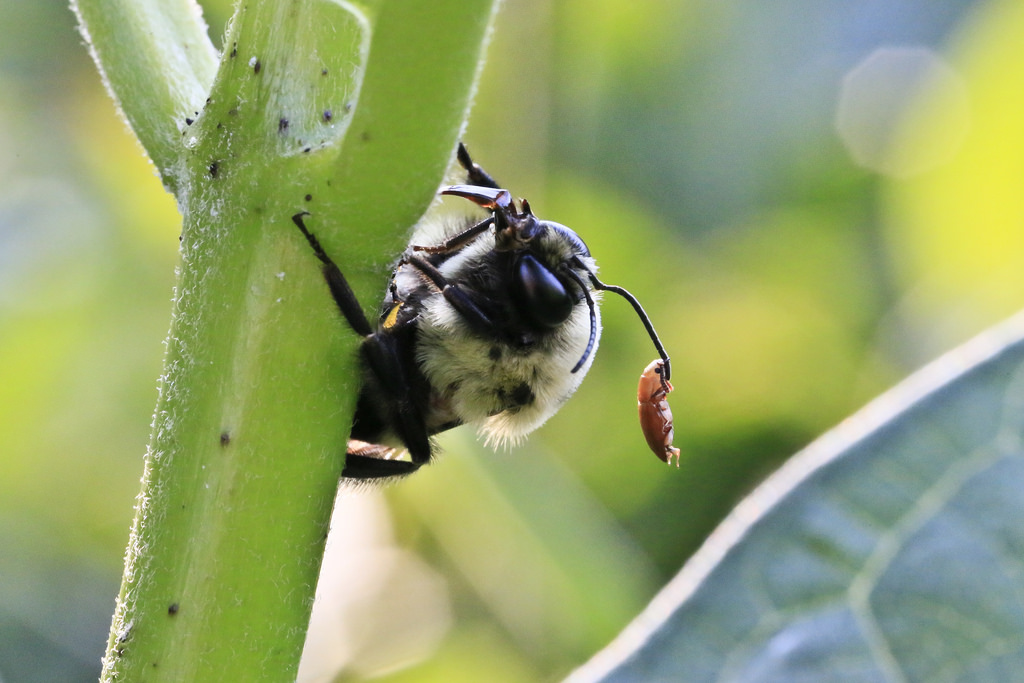Map Snapshot


1 Record
Relationships
According to BugGuide, Antherophagus ochraceus develop in the nests of bumblebees. They also use bumblebees to travel.
Seasonality Snapshot
Source: Wikipedia
| Antherophagus ochraceus | |
|---|---|

| |
| Scientific classification | |
| Domain: | Eukaryota |
| Kingdom: | Animalia |
| Phylum: | Arthropoda |
| Class: | Insecta |
| Order: | Coleoptera |
| Suborder: | Polyphaga |
| Infraorder: | Cucujiformia |
| Family: | Cryptophagidae |
| Genus: | Antherophagus |
| Species: | A. ochraceus
|
| Binomial name | |
| Antherophagus ochraceus Melsheimer, 1844
| |
| Synonyms | |
| |
Antherophagus ochraceus is a species of silken fungus beetle in the family Cryptophagidae.[1][2][3] It is found in North America.[2]
A. ochraceus is one of the largest cryptophagid species. Adults measure 4-5 mm in length. It can be distinguished from similar species by its larger size, entirely yellow body, golden pubescence, small eyes, and smooth, curved pronotum.[4]
The adult beetles are found on flowers, where they eat pollen and nectar and interact with bumblebees.[5] They can be found from May to September.[4] A. ochraceus, along with some other members of Cryptophagidae, engage in phoresy. The beetles are transported by attaching to the legs, mouthparts, or antennae of bumblebees. It remains attached by clamping down with its mandibles.[6] It does not release until the bee returns to its nest. A. ochraceus adults lay eggs in bumblebee nests, where the eggs develop into larvae. In the larval stage, the beetles remain in the nest and eat organic matter and detritus. Specifically, they are presumed to consume honey, bee feces, and comb debris.[6][7]
References
[edit]- ^ "Antherophagus ochraceus Species Information". BugGuide.net. Retrieved 8 February 2018.
- ^ a b "Antherophagus ochraceus Report". Integrated Taxonomic Information System. Retrieved 8 February 2018.
- ^ "Antherophagus ochraceus Overview". Encyclopedia of Life. Retrieved 8 February 2018.
- ^ a b "Cryptophagidae of Canada". cjai.biologicalsurvey.ca. Retrieved 21 July 2022.
- ^ Bousquet, Yves (1989). "A Review of the North American Genera of Cryptophaginae (Coleoptera: Cryptophagidae)". The Coleopterists Bulletin. 43 (1): 1–17. ISSN 0010-065X.
- ^ a b Wheeler, William Morton (1919). "The Phoresy of Antherophagus". Psyche: A Journal of Entomology. 26 (6): 145–152. doi:10.1155/1919/93829. ISSN 0033-2615.
- ^ Frison, Theodore H. (1921). "Antherophagus ochraceus Mels. In the Nests of Bumblebees". The American Naturalist. 55 (637): 188–192. ISSN 0003-0147.
Further reading
[edit]- Arnett, R. H. Jr.; Thomas, M. C.; Skelley, P. E.; Frank, J. H., eds. (21 June 2002). American Beetles, Volume II: Polyphaga: Scarabaeoidea through Curculionoidea. CRC Press LLC, Boca Raton, Florida.
- Arnett, Ross H. (30 July 2000). American Insects: A Handbook of the Insects of America North of Mexico. CRC Press. ISBN 978-0-8493-0212-1.
- White, Richard E. (1983). Peterson Field Guides: Beetles. Houghton Mifflin Company.
- Majka, C; Langor, D (2010). "Contributions towards an understanding of the Cryptophaginae (Coleoptera, Cryptophagidae) of Atlantic Canada". ZooKeys (35): 13–35. doi:10.3897/zookeys.35.314.
